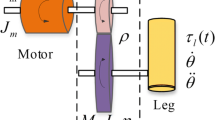Abstract
In this paper, we present a new concept of the mechanical design of a humanoid robot. The goal is to build a humanoid robot utilizing a new structure which is more suitable for human-like walking with the characteristics of the knee stretch, heel-contact, and toe-off. Inspired by human skeleton, we made an anthropomorphic pelvis for the humanoid robot. In comparison with conventional humanoid robots, with such the anthropomorphic pelvis, our robot is capable of adjusting the center of gravity of the upper body by the motion of pelvic tilt, thus reducing the required torque at the ankle joint and the velocity variations in human-like walking. With more precise analysis of the foot mechanism, the fixed-length inverted pendulum can be used to describe the dynamics of biped walking, thus preventing redundant works and power consumption in length variable inverted pendulum system. As the result of the new structure we propose, a humanoid robot is able to walk with human-like gait.
Similar content being viewed by others
References
Hirai K, Hirose M, Haikawa Y, Takenaka T. The develop-ment of Honda humanoid robot. Proceeding of the IEEE International Conference on Robotics and Automation (ICRA), Leuven, Belgium, 1998, 1321–1326.
Vukobratovic M, Brovac B, Surla D, Stokic D. Biped Lo-comotion: Dynamics, Stability, Control and Application, Springer-Verlag, New York, USA, 1990.
Ogura Y, Shimomura K, Kondo H, Morishima A, Okudo T, Momoki S, Lim H, Takanishi A. Human-like walking with knee stretched, heel-contact and toe-off motion by a hu-manoid robot. Proceeding of the 2006 IEEE/RSJ International Conference on Intelligent Robot and Systems (IROS), Beijing, China, 2006, 3976–3981.
Kaneko K, Kanehiro F, Morisawa M, Miura K, Nakaoka S, Kajita S. Cybernetic Human HRP-4C. Proceeding of the 2009 IEEE-RAS International Conference on Humanoid Robots, Paris, France, 2009, 7–14.
Omer A, Ghorbani R, Lim H, Takanishi A. Semi-passive dynamic walking for humanoid robot using controllable spring stiffness on the ankle joint. Proceedings of the 2009 4th International Conference on Autonomous Robots and Agents, Wellington, New Zealand, 2009, 681–685.
Kondo H, Ogura Y, Shimomura K, Momoki S, Okubo T, Lim H, Takanishi A. Emulation of human walking by biped humanoid robot with heel-contact and toe-off motion. Journal of Robotics and Mechatronics, 2008, 20, 739–749.
Lee H M, Moroz A. Physical Therapy, [2013-03], http://www.merckmanuals.com/professional/special_subjects/rehabilitation/physical_therapy_pt.html
Gray H. The Pelvis, [2013-03], http://www.bartleby.com/107/58.html
Schache A G, Blanch P D, Murphy A T. Relation of anterior pelvic tilt during running to clinical and kinematic measures of hip extension. British Journal of Sports Medicine, 2000, 34, 279–283.
Elert G. Center of Mass of a Human, [2013-03], http://hypertextbook.com/facts/2006/centerofmass.shtml
Gajdosik R, Simpson R, Smith R, DonTigny R L. Pelvic tilt. Intratester reliability of measuring the standing position and range of motion. Journal of the American Physical Therapy Association, 1985, 65, 169–174.
Lou X, Li W, Zhu C. Planning and control of COP-switch-based planar biped walking. Journal of Bionic Engineering, 2011, 8, 33–48.
Lou X, Guo R, Zhu C. An orbit based control for biomimetic biped walking. Proceeding of IEEE International Conference on Robotics and Biomimetics, Guilin, China, 2009, 19–23.
Lou X, Xu W. Planning and control for passive dynamics based walking of 3D biped robots. Journal of Bionic Engineering, 2012, 9, 143–155.
Xiang Y, Arora J S, Abdel-Malek K. Optimization-based prediction of asymmetric human gait. Journal of Biome-chanics, 2011, 44, 683–693.
Lister S J, Jones N B, Spurgeon S K, Scott J J A. Simulation of human gait and associated muscle activation strategies using sliding-mode control techniques. Journal of Simula-tion Modeling Practice and Theory, 2006, 14, 586–596.
Fernandez J W, Pandy M G. Integrating modeling and ex-periments to assess dynamic musculoskeletal function in humans. Experimental Physiology, 2006, 91, 371–382.
Author information
Authors and Affiliations
Corresponding author
Rights and permissions
About this article
Cite this article
Chiang, MH., Chang, FR. Anthropomorphic Design of the Human-Like Walking Robot. J Bionic Eng 10, 186–193 (2013). https://doi.org/10.1016/S1672-6529(13)60214-0
Published:
Issue Date:
DOI: https://doi.org/10.1016/S1672-6529(13)60214-0




